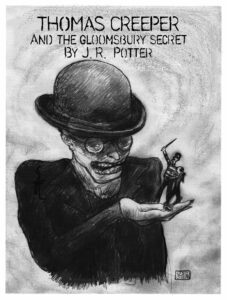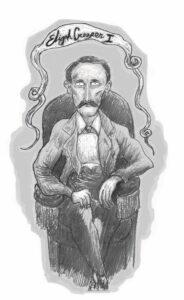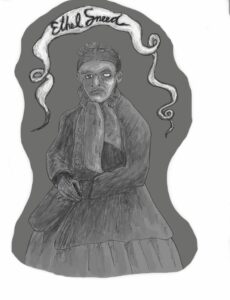I had the delightful opportunity recently to interview J.R. Potter, the winner of our 2019 Kraken Book Prize for Middle-Grade Fiction, and to discover the ins and outs of his literary leanings and muses and how they influenced the formulation of his delightfully creepy work, Thomas Creeper and the Gloomsbury Secret, which will be released by Fitzroy Books in 2021. I hope you enjoy his responses below as much as I did! – Jaynie Royal, Editor-in-Chief
JR: So, kids-Gothic. Is this a sub-genre of middle grade fiction that you are familiar with? Have you seen other titles of this kind for kids or do you feel that you are working in a new literary sub-category?

JP: I suppose it is, if not necessarily in name definitely in form. I think the chemical equation of the Victorian period combined with the Good versus Evil superstitions of our Western culture and religions has made a lasting impact on the literary world, books for young people being no exception.
A touchstone for this kind of writing for me was the work of John Bellairs (1938-1991) who wrote middle-grade “kids-Gothic” classics like The House with a Clock in Its Walls which I’m happy to see has finally received its big screen debut with the recent movie starring Jack Black and Cate Blanchett. Bellairs was a slightly pudgy, lonely child with an incredible imagination. He would have been influenced by horror writers like M.R. James who when asked to write an introduction to his work by his publisher managed to let slip a little bit about his philosophy and approach to crafting a good horror story, one which I believe Bellairs would later follow in his own spooky work. Poorly paraphrased M.R. James’s philosophy of good horror writing is this: let the reader meet the story’s unsuspecting victims or heroes in their safest environment—feet up, not a care in the world. Then slowly, little by little, introduce the menace of the story until he/she/it holds the stage until the grand finale.

I often use this approach when writing my creepy stories. Sometimes I combine it with something I learned from watching The X-Files (Millenials: The X-Files was a groundbreaking paranormal series in the Dark Ages of the 1990’s before Snapchat, Instagram, and memes about cats). An X-Files episode often begins with a two-minute teaser where the viewer is introduced to some bewildering event that is strangely captivating but does not spell out in clear terms what exactly is happening. It then sets up the detective efforts of the main characters, agents Mulder and Scully, as they go about investigating the crime or strange supernatural event. It’s a great “shot across the bow” kind of approach that both bewilders and hooks the viewer into caring about the evolving drama. I do that with Thomas Creeper in the Prologue. We see some sort of submersible rise in Gloomsbury Bay and two characters—one of them not exactly human—get out and survey the landscape. It ends with one of them offering an ominous prediction of what’s about to unfold. I wanted to create a feeling of dread with this opening scene like “these might be good guys and then again they might not.” You have to trust the reader’s intelligence and let them decide.
Books in the “kids-Gothic” department other than Bellairs’ opus that have greatly influenced me are the Warren the Thirteenth books, an amazing illustrative storytelling collaboration between comic superstar Tania del Rio and brilliant artist Will Staehle; The Monstrumologist series by Rick Yancey that falls somewhere between upper middle-grade and young adult; and last but not least, a small picture book by Jack Prelutsky called It’s Halloween perhaps one of my earliest memories of spooky fiction that came with a record (a record! Eeeeek!) that scared my eight-year-old socks off. Marilyn Haffner’s illustration in the book unlocked a lot of visual doors for me: ghosts pouring out of open windows like billowing curtains, monsters having their own Halloween night party complete with cocktails and a ghoulish piano player. There’s one little vignette that’s just a countdown of ghosts the reader doesn’t see: some sitting on the staircase or lingering in the foyer. Marvelous and hair-raising stuff that I must admit I cannot forget, for good or for ill.
JR: Your work is delightfully creepy! Can you tell us a little more about what inspired the birth and growth of Thomas Creeper as a literary protagonist?
JP: The first incarnation of the story began with the zinger line “What do I do with eyes?” It was a scene in which Thomas and his overbearing father are standing over a fresh corpse in the Preparing Room at the Creeper & Sons Funeral Home and Thomas, the reluctant mortician’s apprentice, wants to know what to do with eyes staring up at him.

The scene was perhaps a little too “on the nose” as they say—not to mention a little more than jarring as the introduction to the book. But I liked this absurd and frightful exchange between a father and son. While Thomas Creeper is definitely a creepy, supernatural romp through my fictitious world of Gloomsbury, Massachusetts, it’s really about relationships—father and son, boy becoming young man, boy wondering whether he wants to muddy things up by liking a girl more than just platonically. I grew up in a very loving situation with lots of support and encouragement. While Thomas’s situation of fighting a life and job he doesn’t want to inherit was never my experience, I am concerned for young people who are struggling to have their voices heard and coming up against a lot of resistance. I know this is a huge part of growing up in general, but I wanted to create a sympathetic character who might resonate with young people who are struggling, who don’t fit into a neat and tidy box, and show them that there is always help around the corner and another path to go down, even if it means a little heartbreak in the short term. That’s my “spiritual intention goal” for the Thomas Creeper series if I can be so pretentious. The industry is so fickle with its likes and trends, but if I can make something that resonates with a handful of young people—or even just one—then that would mean success to me. As far as the writing being “delightfully creepy” I gratefully accept and submit to this observation 🙂
One thing I learned from Tim Burton animations and movies over the years is that there are monsters and then there are unholy, ungodly terrifying menaces. Sometimes the latter don’t have gnashing teeth or slither under beds. They are unreasonable forces of unmitigated ire and ill will. They lack empathy and are blinded by misguided desire. They could be a school principal who should be holding a cattle prod instead of a pen for writing out demerit and detention slips, or a town mayor who wants to bulldoze a park to put in “custom homes” that of course all look absolutely identical. Young people are very concerned with fairness. While they might not possess all of the right tools in the tool chest gifted by experience, it’s that strong feeling of justice that often motivates them to great things where older brains and hearts stay jaded and insincere. I would like to believe that my lead characters Thomas Creeper and his best friend Jeni Myers typify this desire to do the right thing without needing a gold star. If there’s anybody who needs a gold star in his miserable world it’s Thomas Creeper. The fact that he perseveres and pushes on through adversity is testament I think to his noble soul. If he existed I believe any young person would love to count him as a friend.
JR: Stephen King, when asked how he could write such chilling works, famously replied that he had the heart of a little boy, and he kept it in a jar on his desk. What do you do to summon up the muse?
JP: I love this quote from the master of mayhem and suspense! I consider myself a very talented hack. I kind of hack my way through an unknown jungle and once that path is clear I might install a few lanterns to light the faces of creepy things lingering in the deeper brush. I think the day I figure out where this inspiration comes then I’ll probably not be very good at my job. Even if I know something I’m writing is not strong or clear at the moment, if I have that wild, tingly buzz about me when I write it, I have faith that it’s probably worth saving and just needs more work and pruning. That’s not saying that it’s all Pulitzer magic all the time; but it’s at least some good sleight-of-hand magic, and as you get better at your craft you are able to hide the covering up of the magic trick a little bit better. I wish I was better at outlining a story ahead of time. I do it quite frequently and am jealous of people like J.K. Rowling whose handwritten outlines leaked online are positively awesome. I have general high and low points for the characters that I know I want to hit over the course of the story. I can see it all vaguely in my mind’s eye. But if I knew the exact footing to get there I don’t think I’d bring as much fun and emotion to the journey for the reader or for myself. If I’m not excited and want to type on I can only assume a reader won’t care to flip a page.
JR: What lessons does Thomas Creeper and the Gloomsbury Secret have for its young readers? What do you think is important for them to take away from this book?
JP: Young people are a kaleidoscope of possibilities. The great educators and mentors in my life have always approached their lessons with me in this respect, never trying to hammer home something that doesn’t serve my better interest or nature. If I can stay on my soapbox a few moments longer I’d say that young people shouldn’t feel they need to sum their whole entire being up in one mission statement or put it on display in some physical or even creative act of competition. Yes, competition makes you rise to the occasion (if the Kraken contest didn’t exist I probably wouldn’t have spent time editing Thomas Creeper and getting it ready for other eyes). But failing—or rather what you perceive in the short term as failure—is an amazing teacher. It’s hard to talk about this subject without sounding like you are calling out from atop an ivory tower composed of soapboxes. We all know that young people are lectured way too much by old people who probably aren’t listening hard enough to try to get to the heart of their problem. I would just add this: when your skills and craft have been honed after lots of hard work and critique (self critique and outside) then the opportunities will arise. Maybe somebody else said it first, but I’d like to pretend I said it second: “Talent makes its own luck.” You don’t need a billion followers online if you are putting out vacuous, meaningless garbage. Focus on the integrity of your voice first and foremost and like the composer Gustav Mahler said, “Those who need me will find me.” Those who need you, who are your true friends and allies, they will always find you and stick by your side.
JR: Which of the antagonists in this work is your favorite and why?
JP: The Big Bad Guy I’ll call him not to spoil anything for those who won’t read the book for a bit. He’s terribly eloquent which frightens me. Though it’s definitely not a show for children, one of the greatest works of television I’ve ever seen is True Detective Season One. Those creators got the scary, backwater bayou feel of Louisiana down perfect. A swamp is a living world that’s also full of dead things. The main antagonist in this grisly tale turns out to be as loathsome in his deeds as he is eloquent in his words, capable of committing atrocious acts of violence while summoning Shakespearean verse. These types of villains are the most powerful to me because their intelligence should steer them to lawful action. But there’s a fork in the road and they choose that path and they don’t swerve from it. The great actor Javier Bardem’s portrayal of the villain in No Country for Old Men is another prime example of somebody who is clearly insane but whose logic for his actions makes its own kind of sense. We want our monsters to be one-sided forces of malevolence. But what if that malevolence, that evil was rational? And what if the evil was internal to us, not external, that we shared that same “heart of darkness”? To me that is a far more terrifying proposition. My Big Bad Guy, while I wish he had more time on the page—maybe he will someday, hint, hint—frightens me because he knows how to fabricate a good story where he believes he’s the hero not the villain.

JR: What are you working on next?
JP: Too many things! I’ve been laboring over an Alice in Wonderland meets Blade Runner sci-fi adventure for many years. It involves a lot of extrapolations of how the rising tide of xenophobia in the world might combine with our current evolving technologies like 3D printing on a grand scale (i.e. to 3D print walled cities in a horrible, racist MineCraft), as well as genetic engineering and artificial intelligence. Like a lot of my books I start running before I know how to walk, so I always need to back up a few steps and learn the footing. The aforementioned story is told through the first-person perspective of a seventeen year-old African-American young woman whose life is turned upside down by a horrible murder and she must now work her way out of a terrible rabbit hole to survive. I’m in love with underdogs. I feel like I often write about underdogs for underdogs (I should get that on a business card! J.R. Potter: Engaging Fiction about Underdogs for Underdogs). I also have my first picture book I’m working on called Victor Jr.’s Haunted Supermarket. It’s about the son of Dr. Frankenstein who doesn’t want to build monsters but supermarkets where monsters can shop in peace. The book is basically his extended pitch to his father about why the idea is marketable and how The Mummy could sell toilet paper and Mrs. Creature, the Bride of Frankenstein, could model ladies skincare products. It’s again about fathers and sons with a dash of monstrous humor and a whole lot of heart…a cadaverous, electrically-charged heart, that is.
JR: You are also an accomplished illustrator of graphic novels. How do you divide your time between drawing and writing? How does one influence the other?

JP: Actually the graphic novel work I’ve had published I’ve worked in a capacity as creator and writer (The Glimmer Society, first appearance in Void Trip by Image Comics in December ’17). The art has been drawn, inked, and colored by a collaborator, the comic artist Plaid Klaus, who visually balances terror and humor quite nicely in his work. I’ve been developing my own illustrative style for some time, learning from professionals like Plaid Klaus, as well as clean line heroes like Carson Ellis (illustrator of magical middle-grade works like The Mysterious Benedict Society and Wildwood Imperium among other things). I don’t have a Pinterest board per se, but I take screenshots of work I come across that blows my mind and have created a veritable “smile file” of styles that excite and inspire me. Like any other craft you can study and study but you are going to still be you at the end of the day. That realization is freeing (and sobering sometimes when you recognize your own limitations, a really important step in your evolution as a creator). If you can make your limitations your strengths the work will be gorgeous. Right now I’m playing with a woodblock style for interior sketches for Thomas Creeper. It’s definitely nothing new, actually quite old by illustrative standards. But texturally I’m hoping it will support the creepy mood of the text. As far as time management goes, I go through periods of creativity in writing and drawing. Sometimes they are parallel. I probably should have chosen one path, writing or drawing, long ago. It may not be possible to do both, but you better bet your undead dollar I’m gonna try!

Interesting interview; it helps me overcome my aversion for horror and adjacent genres. Congratulations for winning the Kraken Book Prize, mr. Potter.
Rgds,
Pim Wiersinga